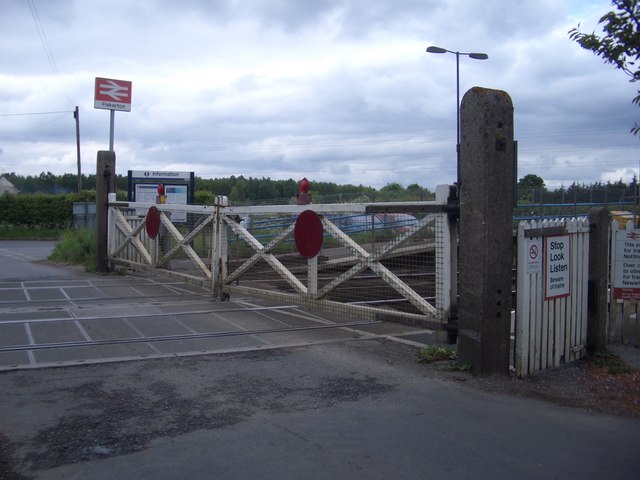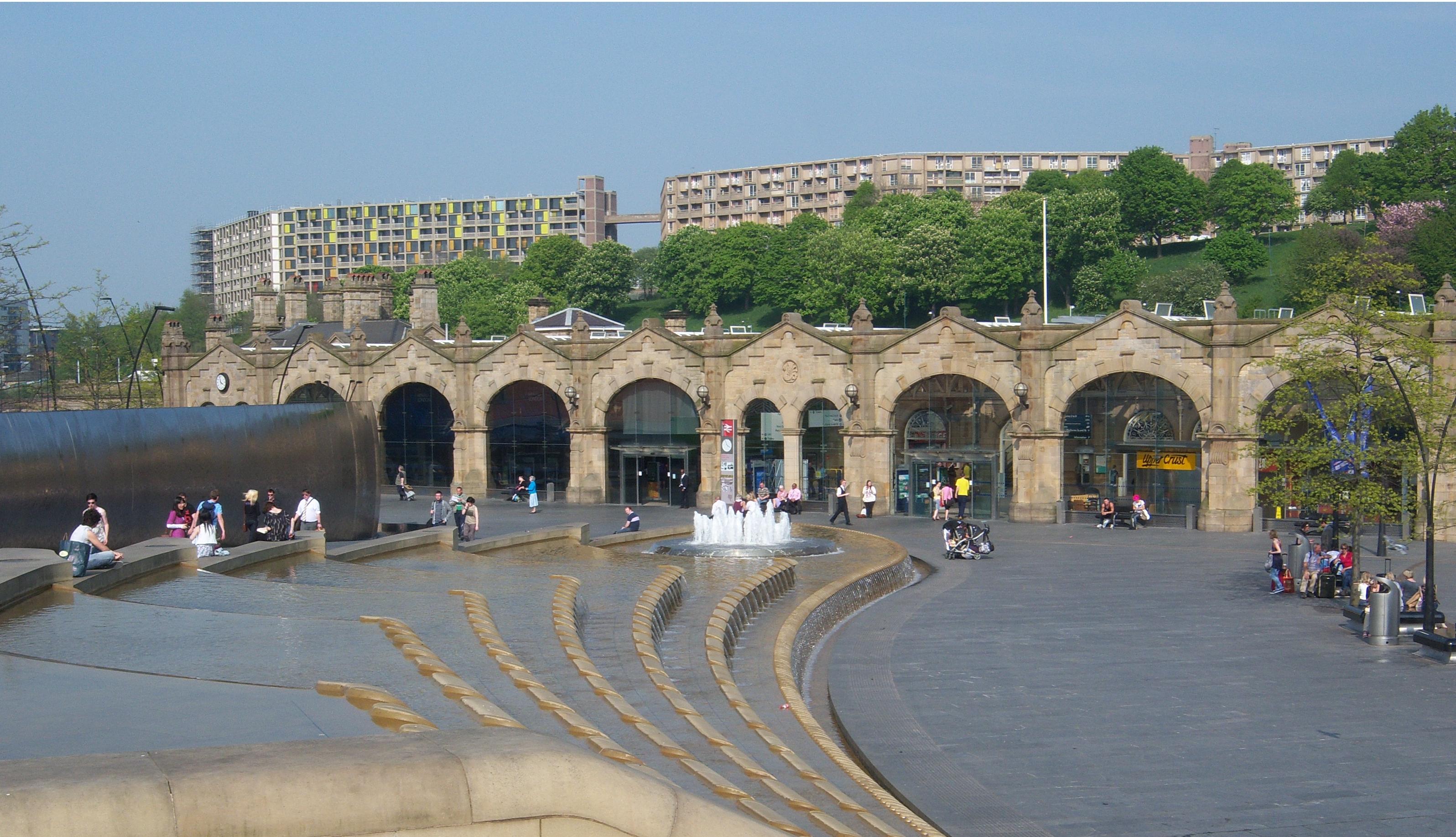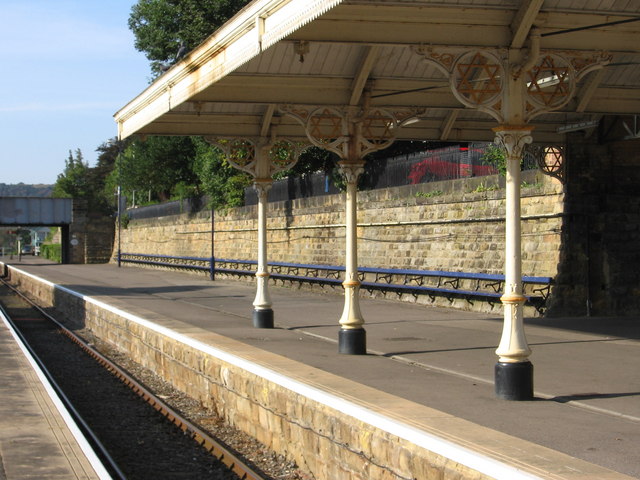|
Saltmarshe Station
Saltmarshe railway station is a railway station on the Hull and Doncaster Branch between Goole and Gilberdyke stations. It serves the village of Laxton, East Riding of Yorkshire, England. The station was opened in 1869 as part of the North Eastern Railway's Hull and Doncaster Branch. Description The station and all trains serving it are operated by Northern. There used to be a signal box at the west end of the platforms on the southern side of the line, which controlled the level crossing at the site. It was abolished and removed in the autumn of 2018 as part of signalling upgrade work in the area. It is named after Saltmarshe, one mile south of the station, on the north bank of the River Ouse. Facilities at the unstaffed station are basic, with no ticketing provision and no permanent buildings other than waiting shelters on each platform. Train information can be obtained from timetable posters or by telephone. There is step-free access on each side, but the Hull-bound ... [...More Info...] [...Related Items...] OR: [Wikipedia] [Google] [Baidu] |
Laxton, East Riding Of Yorkshire
Laxton is a village and civil parish in the East Riding of Yorkshire, England. The village is situated approximately east from Howden and south-east from the county town of York. The civil parish is formed by the village of Laxton and the hamlets of Cotness, Metham and Saltmarshe. A very small part of Yokefleet also falls within the parish. According to the 2011 UK census, Laxton parish had a population of 314, a reduction on the 2001 UK census figure of 322. Laxton lies within the Parliamentary constituency of Haltemprice and Howden an area that mainly consists of middle class suburbs, towns and villages. The area is affluent, placed as the 10th most affluent in the country in a Barclays Private Clients survey, and has one of the highest proportions of owner-occupiers in the country. The village is served by Saltmarshe railway station on the Sheffield to Hull Line. In 1823 Laxton was in the civil parish of Howden, and in the Wapentake and Liberty of Howdenshire. Po ... [...More Info...] [...Related Items...] OR: [Wikipedia] [Google] [Baidu] |
Barrow Crossing
There are around 6,000 level crossings in the United Kingdom, of which about 1,500 are public highway crossings. This number is gradually being reduced as the risk of accidents at level crossings is considered high. The director of the UK Railway Inspectorate commented in 2004 that "the use of level crossings contributes the greatest potential for catastrophic risk on the railways." The creation of new level crossings on the national network is banned (the exception being reopening unavoidable crossings on new/reopening railway lines, and on heritage railways), with bridges and tunnels being the more favoured options. The cost of making significant reductions, other than by simply closing the crossings, is substantial; some commentators argue that the money could be better spent. Some 5,000 crossings are user-worked crossings or footpaths with very low usage. The removal of crossings can improve train performance and lower accident rates, as some crossings have low rail speed li ... [...More Info...] [...Related Items...] OR: [Wikipedia] [Google] [Baidu] |
Railway Stations In Great Britain Opened In 1869
Rail transport (also known as train transport) is a means of transport that transfers passengers and goods on wheeled vehicles running on rails, which are incorporated in tracks. In contrast to road transport, where the vehicles run on a prepared flat surface, rail vehicles (rolling stock) are directionally guided by the tracks on which they run. Tracks usually consist of steel rails, installed on sleepers (ties) set in ballast, on which the rolling stock, usually fitted with metal wheels, moves. Other variations are also possible, such as "slab track", in which the rails are fastened to a concrete foundation resting on a prepared subsurface. Rolling stock in a rail transport system generally encounters lower frictional resistance than rubber-tyred road vehicles, so passenger and freight cars (carriages and wagons) can be coupled into longer trains. The operation is carried out by a railway company, providing transport between train stations or freight customer faciliti ... [...More Info...] [...Related Items...] OR: [Wikipedia] [Google] [Baidu] |
Former North Eastern Railway (UK) Stations
A former is an object, such as a template, gauge or cutting die, which is used to form something such as a boat's hull. Typically, a former gives shape to a structure that may have complex curvature. A former may become an integral part of the finished structure, as in an aircraft fuselage, or it may be removable, being using in the construction process and then discarded or re-used. Aircraft formers Formers are used in the construction of aircraft fuselage, of which a typical fuselage has a series from the nose to the empennage, typically perpendicular to the longitudinal axis of the aircraft. The primary purpose of formers is to establish the shape of the fuselage and reduce the column length of stringers to prevent instability. Formers are typically attached to longerons, which support the skin of the aircraft. The "former-and-longeron" technique (also called stations and stringers) was adopted from boat construction, and was typical of light aircraft built until the ad ... [...More Info...] [...Related Items...] OR: [Wikipedia] [Google] [Baidu] |
DfT Category F2 Stations
The Department for Transport (DfT) is a department of His Majesty's Government responsible for the English transport network and a limited number of transport matters in Scotland, Wales and Northern Ireland that have not been devolved. The department is run by the Secretary of State for Transport, currently (since 25 October 2022) Mark Harper. The expenditure, administration and policy of the Department for Transport are scrutinised by the Transport Committee. History The Ministry of Transport was established by the Ministry of Transport Act 1919 which provided for the transfer to the new ministry of powers and duties of any government department in respect of railways, light railways, tramways, canals and inland waterways, roads, bridges and ferries, and vehicles and traffic thereon, harbours, docks and piers. In September 1919, all the powers of the Road Board, the Ministry of Health, and the Board of Trade in respect of transport, were transferred to the new ministry. ... [...More Info...] [...Related Items...] OR: [Wikipedia] [Google] [Baidu] |
Railway Stations In The East Riding Of Yorkshire
Rail transport (also known as train transport) is a means of transport that transfers passengers and goods on wheeled vehicles running on rails, which are incorporated in tracks. In contrast to road transport, where the vehicles run on a prepared flat surface, rail vehicles (rolling stock) are directionally guided by the tracks on which they run. Tracks usually consist of steel rails, installed on sleepers (ties) set in ballast, on which the rolling stock, usually fitted with metal wheels, moves. Other variations are also possible, such as "slab track", in which the rails are fastened to a concrete foundation resting on a prepared subsurface. Rolling stock in a rail transport system generally encounters lower frictional resistance than rubber-tyred road vehicles, so passenger and freight cars (carriages and wagons) can be coupled into longer trains. The operation is carried out by a railway company, providing transport between train stations or freight customer faciliti ... [...More Info...] [...Related Items...] OR: [Wikipedia] [Google] [Baidu] |
Gilberdyke Railway Station
Gilberdyke railway station is a railway station that serves the village of Gilberdyke in the East Riding of Yorkshire, England. It was opened in 1840 by the Hull and Selby Railway, and until 1974 it was known as Staddlethorpe station. Today it is operated by the Northern train operating company. Situated west of Hull, it is the junction for the lines to Selby and to and Doncaster. History Staddlethorpe station was opened by the Hull and Selby Railway in 1840. The original facilities included a water station, with a reservoir and pumping engine. In 1842 a train guard slipped in wet weather, falling off the platform under moving coal wagons, resulting in very serious injuries leading to his death. In 1850 a train from Hull to Normanton had one of its engine's boilers explode near the station. Both the driver and fireman were badly scalded, and the fireman broke a leg. In 1869 the Hull and Doncaster Branch opened, branching south-westwards from a junction just west of the sta ... [...More Info...] [...Related Items...] OR: [Wikipedia] [Google] [Baidu] |
Goole Railway Station
Goole railway station is a railway station in town of Goole on the Hull and Doncaster Branch in the East Riding of Yorkshire, England. The station and its passenger services are managed and provided by Northern. Lines from Goole run north to the Hull and Selby Line at Gilberdyke (formerly Staddlethorpe); south to the South Humberside Main Line near Thorne; there is also a westward line to Knottingley mostly used by freight, with an infrequent passenger service. The station opened in 1869 replacing a terminus station in the Goole docks. Facilities The station has a ticket office on platform 2 (southbound), which is staffed part-time (07:00 - 13:30) on weekdays and Saturdays only. A self-service ticket machine is available for use outside of these times and for collecting pre-paid tickets. A waiting room and vending machine are provided on platform 2 and a shelter on platform 1, along with extensive canopies on each side. Digital display screens, timetable posters and automat ... [...More Info...] [...Related Items...] OR: [Wikipedia] [Google] [Baidu] |
Sheffield Railway Station
Sheffield station, formerly ''Pond Street'' and later ''Sheffield Midland'', is a combined railway station and tram stop in Sheffield, England; it is the busiest station in South Yorkshire. Adjacent is Sheffield station/Sheffield Hallam University Sheffield Supertram stop. In 2017–18, the station was the 43rd-busiest in the UK and the 15th-busiest outside London. History 1870 - 1960 The station was opened in 1870 by the Midland Railway to the designs of the company architect John Holloway Sanders. It was the fifth and last station to be built in Sheffield city centre. The station was built on the 'New Line', which ran between Grimesthorpe Junction, on the former Sheffield and Rotherham Railway, and Tapton Junction, just north of Chesterfield. This line replaced the Midland Railway's previous route, the 'old road', to London, which ran from Sheffield Wicker via Rotherham. The new line and station were built despite some controversy and opposition locally. The Duke of Norf ... [...More Info...] [...Related Items...] OR: [Wikipedia] [Google] [Baidu] |
Beverley Railway Station
Beverley railway station serves the town of Beverley in the East Riding of Yorkshire, England. It is located on the Hull to Scarborough Line and is operated by Northern who provide most passenger services from the station. History and description Beverley station was opened in October 1846 by the York and North Midland Railway leased Bridlington branch of the Hull and Selby Railway. The original station was designed by G.T. Andrews. Beverley gained junction status nineteen years later in 1865 when the North Eastern Railway completed the Market Weighton to Beverley section of the York to Beverley Line. The station was also planned to be the junction for the North Holderness Light Railway. This intended railway was given an Act in Parliament for 'transferring to the company the North Holderness Light Railway Company; and for other purposes, North Eastern Railway Bill ords' The act was passed on 8 June 1899, but the NER never built the line. The York to Beverley Line closed ... [...More Info...] [...Related Items...] OR: [Wikipedia] [Google] [Baidu] |
Scarborough Railway Station
Scarborough railway station, formerly Scarborough Central, is a Grade II listed station serving the seaside town of Scarborough, North Yorkshire. It lies east of York and is one of the eastern termini on the North TransPennine route, operated by TransPennine Express. The station is also at the northern end of the Yorkshire Coast line and is reputed to have the longest station seat in the world at long. From 1907 until 2010 the station approaches were controlled from a 120-lever signal box named Falsgrave (at the outer end of platform 1 and close to the former excursion station at ). In its final years Falsgrave box controlled a mixture of colour-light and semaphore signals, including a gantry carrying 11 semaphores. The signal box was decommissioned in September 2010 and the gantry was dismantled and removed in October 2010. Its new home was Grosmont railway station, on the North Yorkshire Moors Railway. The new signalling is a relay-based interlocking with two- and three-asp ... [...More Info...] [...Related Items...] OR: [Wikipedia] [Google] [Baidu] |
Doncaster Railway Station
Doncaster railway station is on the East Coast Main Line in England, serving the city of Doncaster, South Yorkshire. It is down the line from and is situated between and on the main line. It is managed by London North Eastern Railway. It is a major passenger interchange between the main line, Cross Country Route and local services running across the North of England. It is also the point for which London North Eastern Railway services branching off to diverge from the main route continuing north towards Edinburgh. History The railway station was built in 1849 replacing a temporary structure constructed a year earlier. It was rebuilt in its present form in 1938 and has had several slight modifications since that date, most notably in 2006, when the new interchange and connection to Frenchgate Centre opened. In May 2015, construction commenced on a new Platform 0 to the north-east of the station adjacent to the Frenchgate Centre on the site of the former cattle dock. It i ... [...More Info...] [...Related Items...] OR: [Wikipedia] [Google] [Baidu] |






_(28634461652).jpg)

